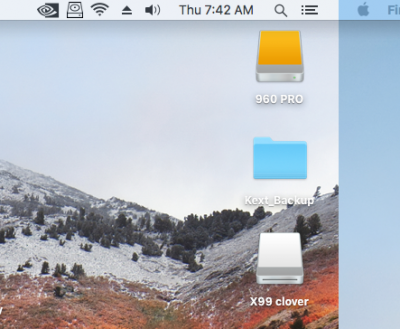Major Broadwell-E/EP (Haswell-E/EP)/X99 macOS High Sierra 10.13 Desktop Guide Revision completed
Summary:
1.)
Important Note: In the frame of Skylake-X i9-7980XE domestication, I made the following discovery with respect to the
"ASUS MultiCore Enhancement" BIOS feature.When ENABLING this BIOS one notes a significant performance boost! In case of the i9-7980XE, the Geeckbench score difference was approx. 51.000 (disabled) compared to 58.000 (enabled)! However, if you enabled ASUS MultiCore Enhancement (opposite to the recommended BIOS settings above; DISABLED), please verify your system stability. I did not enable and verified this BIOS feature yet on my Broadwell-E/X99 rig!
2.)
VT-d Note: For compatibility with VM or Parallels, VT-d can be also ENABLED... Verify however, in this case that in your
config.plist the boot flag "dart=0" is checked under Arguments in the "Boot" Section of Clover Configurator! The boot flag "dart=0" is now implemented by default in the config.plist of the newly attached EFI-Folder at the end of the originating post/guide.
3.)
Maybe one of the most important modifications you will like most  :
: Error Prevention C.1).
Against all my
previous suspicions, that the dead end in the macOS USB FLASH Drive Installer boot process was XHC USB related, I discovered to my big big surprise that the source of the latter issue was exclusively Bluetooth related! I now replaced the formerly in /EFI/CLOVER/kexts/Other/ implemented bluetooth-kexts "BrcmFirmwareData.kext" and "BrcmPatchRAM2.kext" by AirportBrcmFixup.kext v1.1.0, which now correctly implements Bluetooth Airport Controllers like the OSX WIFI Bluetooth +WIFI PCIe Adapter! Note that AirportBrcmFixup.kext v1.1.0 requires the additional implementation of Lilu.kext v1.2.0 in /EFI/CLOVER/kexts/Other/.
I now can fully confirm, that the macOS USB Flash Drive Installer can be plugged on any XHC USB2.0 and USB3.0 and separate USB3.1 ports available (100% verified) with X99_Injector USB 3.kext in /EFI/CLOVER/kexts/Other/ !!!! There is absolutely no need to substitute the X99_Injector USB 3.kext by an optional XHC USB Kext as previously supposed, in order to successfully boot the macOS USB Flash Drive Installer! The macOS USB Flash Drive Installer now boots from any XHC USB2.0 and USB3.0 or separate USB3.1 ports available!
4.)
Firmware Error Prevention C.2.) seems obsolete
5.) In contrary to previous advises in Error prevention c.4),
avoid any MacOS assignments in KextToPatch and
KernelToPatch entries implemented in the "Kernel and Kext Patches" Section of the Clover Configurator. If subsequently in my Guide you still find MatchOS assignments in respective figures or text, just ignore all likely yet persistent MatchOS assignments. In the config.plist of the EFI-Folder attached EFI-Folder at the end of the originating post/guide, all MatchOS assignments have been definitely removed.
6.) With respect the error prevention C.5), the the
"KernelPm" entry in the "Kernel and Kext Patches" Section
of the Clove Configurator is now unchecked by default. Those users not able to successfully boot their System without "KernelPm" now have to check the latter in addition.
7.)
Error Prevention C.9) added! I guess, Error Prevention 9.b) might be by far one of the most crucial error
prevention for all Nvidia Graphics Cards Users!
Before performing any macOS Upgrade, uninstall the former NVIDIA Web Driver and it's NVIDIA Web Driver Manager primer to the MacOS High Sierra Update!!! If you do not remove the former Nvidia Web Drivers primer to the MacOS Update, your System will be unbootable after the MacOS Update!!!
Error Prevention is once more explicitly outlined in D.2.1) and D.3.2)
8.) Entire "Graphics Configuration Section" E.1) modified and revised! Carefully study respective Error
Preventions, Nvidida Web Driver Installation and Black Screen Prevention Instructions, including my very detailed and successful Web Driver Installation and AGDPFix Black Screen Prevention (100% verified!) summary, as well as counter measurement possibilities in case of failure. The second Black Screen Prevention approach based on NvididaGraphicsFixUp.kext (v1.2.0) with Lilu kext support (v1.2.0) only should be applied in case that one really would not succeed with the AGDPFix Black Screen Prevention approach!
Basic support also has been added for all ATI Graphics Card Users by means of Whatevergreen.kext (v1.1.0) with Lilu.kext (v1.2.0) support.
9.) Revision of Section E.2), Audio Configuration: Latest version of AppleALC (v1.2.0) and Lilu (v1.2.0) added to
/EFI/CLOVER/kexts/Other of the EFI-Folder attached at the end of the originating post/guide.
I don't know if now I have forgotten some other modification implemented in the frame of this major revision.
In any case carefully study the revised guide and newly distributed EFI Folder. The latter I once more attach below!
Enjoy and have fun 

